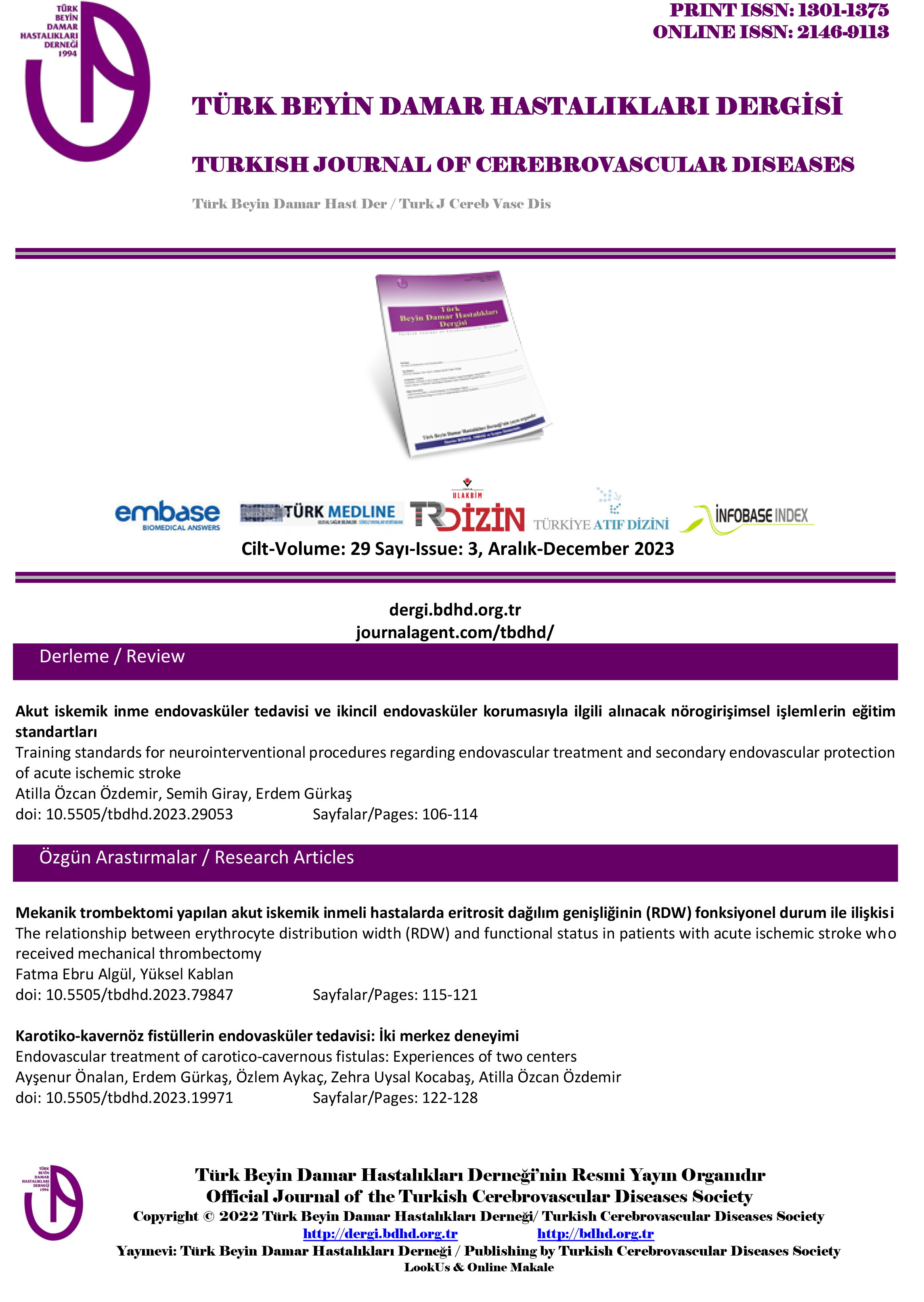Karotis arter stentleme sonrası hipotansiyon gelişen hastaların demografik özelliklerinin ve olası risk faktörlerinin değerlendirilmesi
Feyzullah Cengiz, Hamza Şahin, Mustafa GökçeKahramanmaraş Sütçü İmam Üniversitesi, Tıp Fakültesi, Nöroloji Anabilim Dalı, Kahramanmaraş, TürkiyeGİRİŞ ve AMAÇ: Bu çalışmada karotis arter stentleme (KAS) sonrasında hipotansiyon gelişen hastalarda olası risk faktörlerinin belirlenmesi amaçlandı.
YÖNTEM ve GEREÇLER: Çalışmaya KAS yapılan 104 hasta dahil edildi. KAS sonrasında sistolik kan basıncı 90 mmHgden düşük olan ya da sistolik kan basıncında bazale göre 40 mmHgden daha fazla düşüş yaşayan hastalar hipotansif grup, diğer hastalar ise normotansif grup olarak belirlendi. Bu iki grubun sosyodemografik özellikleri, ek hastalıkları, stent takılan taraf darlık yüzdesi, kontralateral taraf darlık yüzdesi, anjioplasti öyküsü, işlem süresi, femoral kılıf genişliği, işlem öncesinde antihipertansif ilaç kullanımı ve glomerüler filtrasyon hızı, işlem öncesi/sonrası hemoglobin ve hematokrit düzeyleri, hastanede kalış süresi, işlem sonrası komplikasyon sıklığı karşılaştırıldı.
BULGULAR: KAS sonrası 21 hastada hipotansiyon gözlendi. Hipotansif grupta kadın hasta oranı, stent takılan taraf darlık derecesi, femoral kılıf çapı, işlem öncesi glomerüler filtrasyon hızı düşüklüğü ve antihipertansif ilaç kullanımı istatistiksel olarak anlamlı bulundu.
TARTIŞMA ve SONUÇ: Kadın cinsiyet, stent tarafı darlık derecesi yüksekliği ve işlem öncesi antihipertansif ilaç kullanımı KAS sonrası hipotansiyon gelişmesi açısından daha dikkatli takip edilmelidir.
Evaluation of demographic characteristics and possible risk factors of patients who developed hypotension after carotid artery stenting
Feyzullah Cengiz, Hamza Şahin, Mustafa GökçeKahramanmaraş Sütçü İmam University, Faculty of Medicine, Department of Neurology, Kahramanmaraş, TurkeyINTRODUCTION: The aim was to determine possible risk factors in patients who developed hypotension after carotid artery stenting (CAS) in this study.
METHODS: 104 patients who underwent CAS were included in the study. Patients with systolic blood pressure lower than 90 mmHg after CAS or a decrease in systolic blood pressure more than 40 mmHg compared to baseline were defined as the hypotensive group and the other patients as the normotensive group. These two groups were analyzed regarding the following parameters: sociodemographic characteristics, comorbidity diseases, percentage of stented side stenosis, percentage of contralateral side stenosis, history of angioplasty, duration of the procedure, the width of the femoral sheath, antihypertensive medical history, glomerular filtration rate, hemoglobin and hematocrit levels before/after the procedure, length of hospital stay, and the frequency of complications after the procedure.
RESULTS: Hypotension was observed in 21 patients after CAS. The ratio of female patients, the degree of stenosis on the stented side, the diameter of the femoral sheath, the glomerular filtration rate value, and the antihypertensive medical history were significantly higher in the hypotensive group.
DISCUSSION AND CONCLUSION: Especially female gender, a high degree of stenosis on the stented side and antihypertensive medical history should be followed more carefully for the development of hypotension after CAS.
Sorumlu Yazar: Hamza Şahin, Türkiye
Makale Dili: Türkçe










